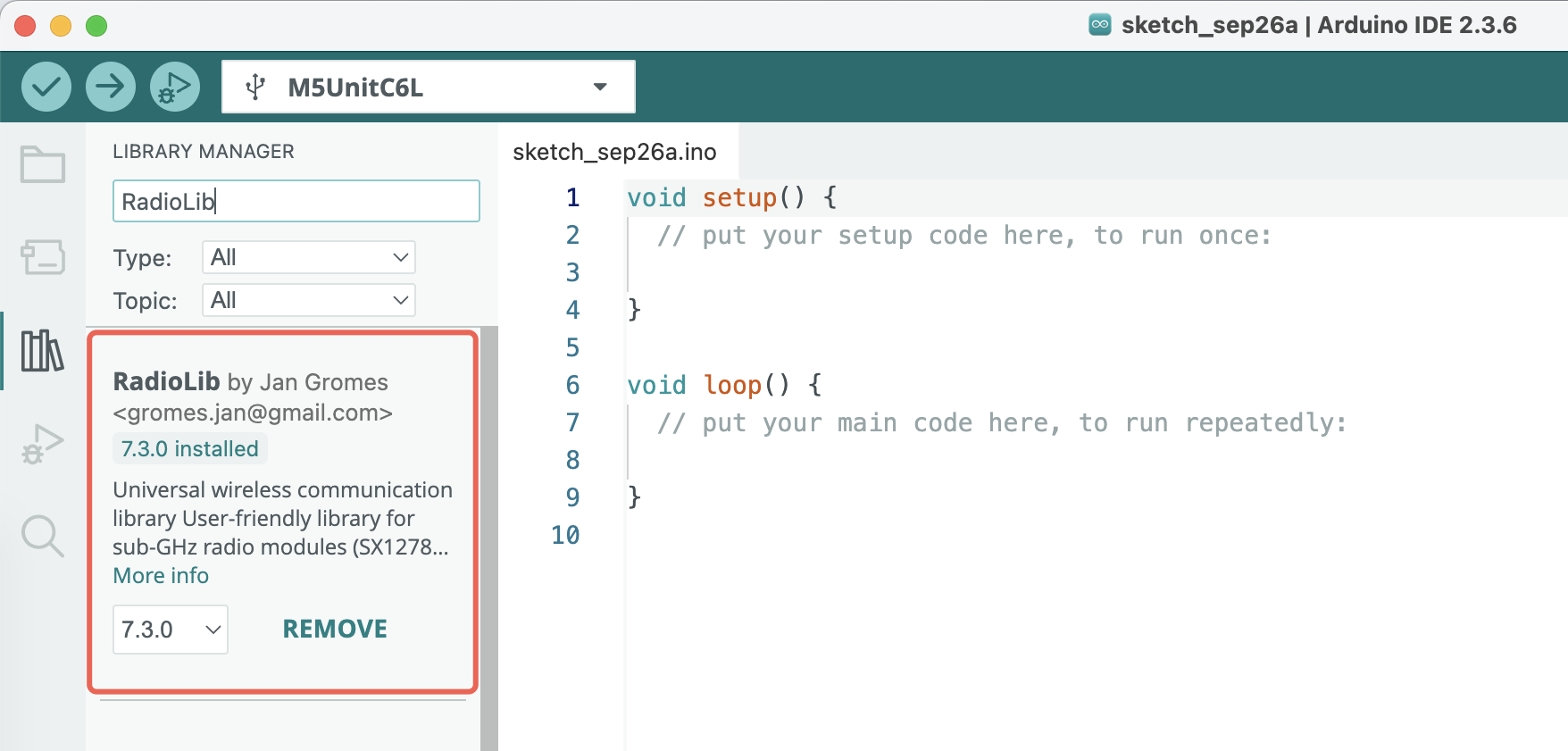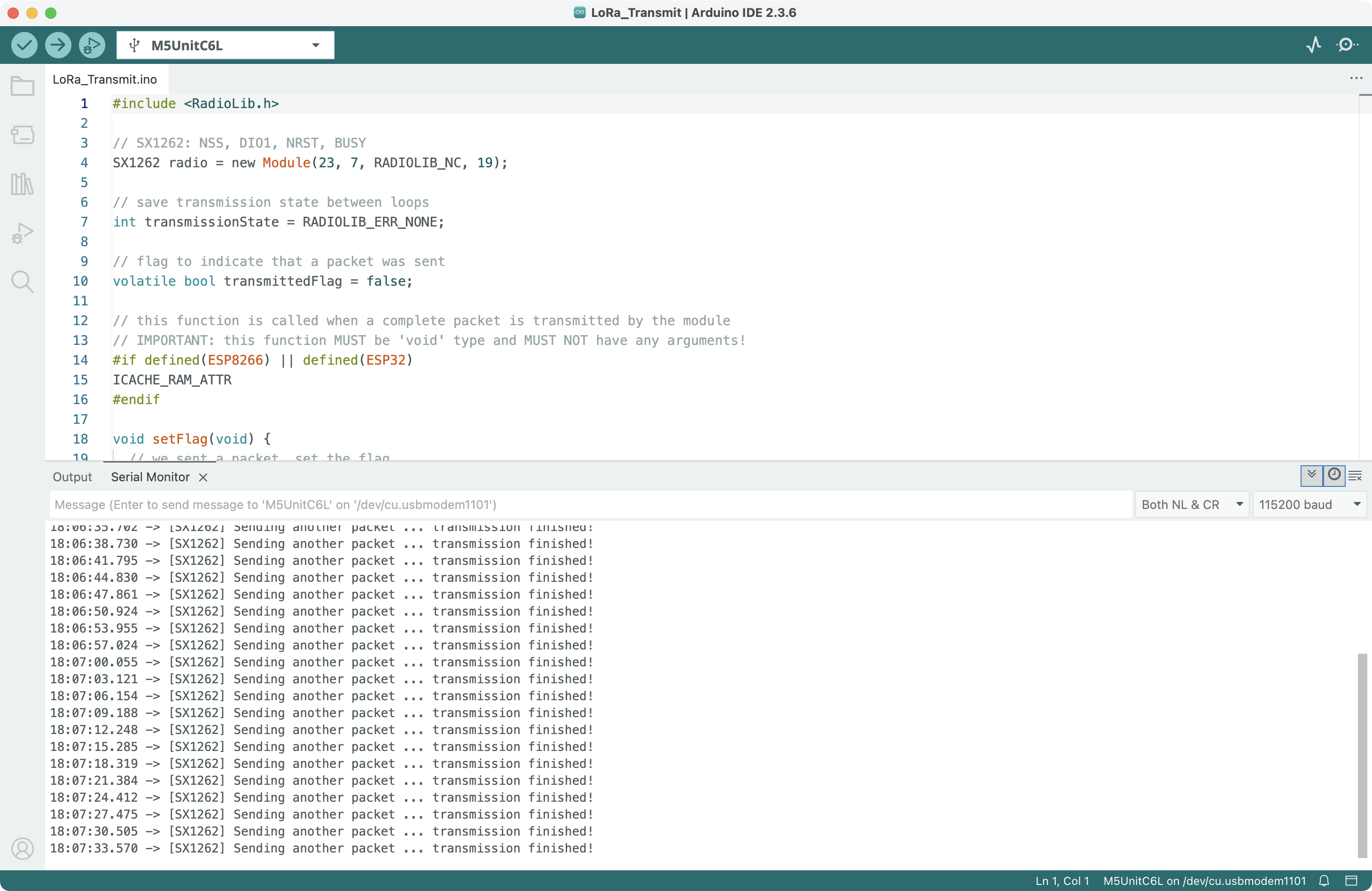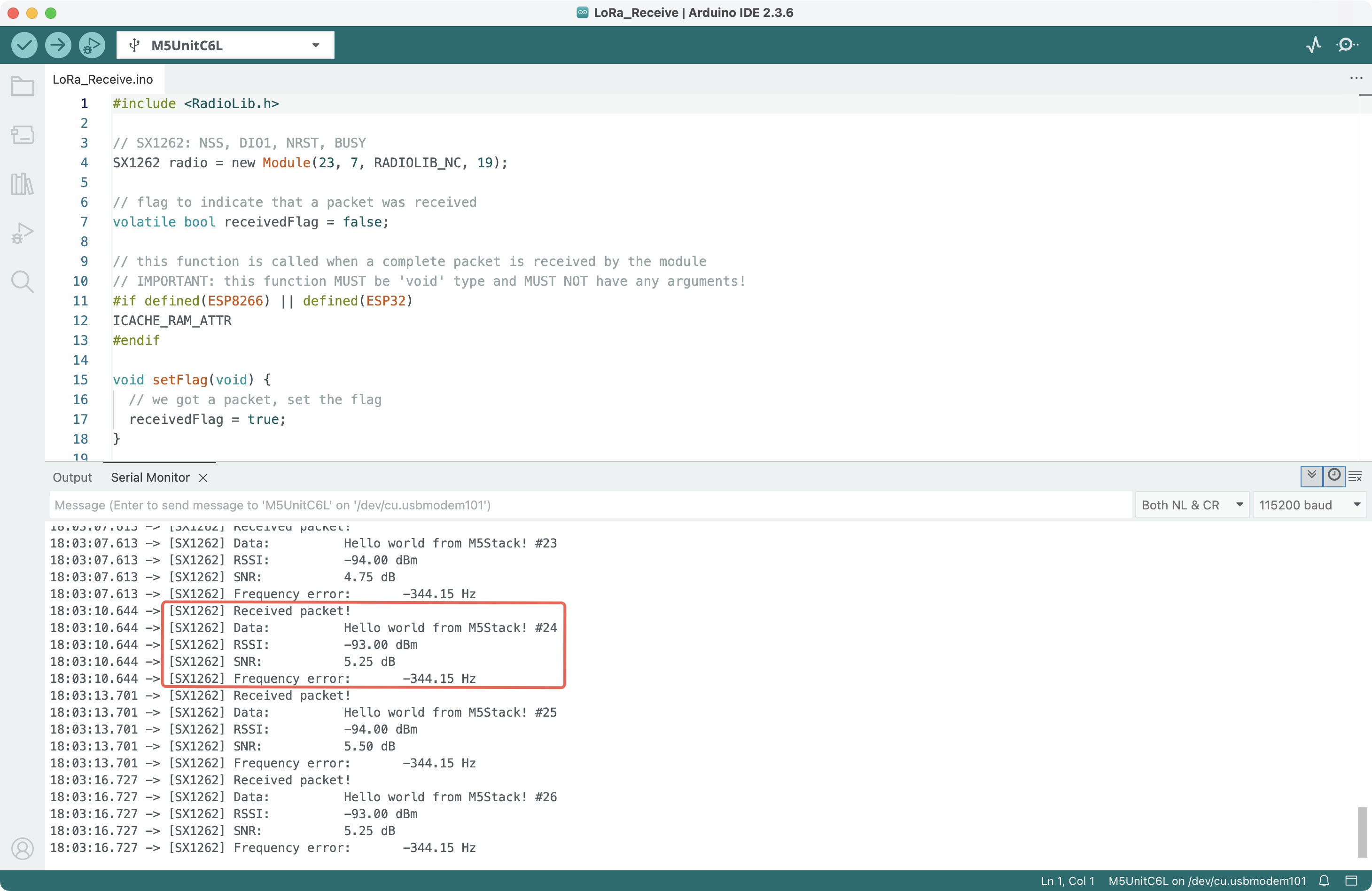Unit C6L LoRa Communication
APIs and example programs related to Unit C6L LoRa communication.
Note
Unit C6L uses the SX1262 LoRa transceiver. When developing, be sure to select the corresponding class.
Example Program
Compilation Requirements
- M5Stack Board Manager version >= 3.2.3
- Board option = M5UnitC6L
- RadioLib library version >= 7.3.0

Transmitter
cpp
1 2 3 4 5 6 7 8 9 10 11 12 13 14 15 16 17 18 19 20 21 22 23 24 25 26 27 28 29 30 31 32 33 34 35 36 37 38 39 40 41 42 43 44 45 46 47 48 49 50 51 52 53 54 55 56 57 58 59 60 61 62 63 64 65 66 67 68 69 70 71 72 73 74 75 76 77 78 79 80 81 82
#include <RadioLib.h>
// SX1262: NSS, DIO1, NRST, BUSY
SX1262 radio = new Module(23, 7, RADIOLIB_NC, 19);
// save transmission state between loops
int transmissionState = RADIOLIB_ERR_NONE;
// flag to indicate that a packet was sent
volatile bool transmittedFlag = false;
// this function is called when a complete packet is transmitted by the module
// IMPORTANT: this function MUST be 'void' type and MUST NOT have any arguments!
#if defined(ESP8266) || defined(ESP32)
ICACHE_RAM_ATTR
#endif
void setFlag(void) {
// we sent a packet, set the flag
transmittedFlag = true;
}
void setup() {
delay(1000);
Serial.begin(115200);
// initialize SX1262
Serial.print(F("[SX1262] Initializing ... "));
// frequency, bandwidth, spreading factor, coding rate, sync word, power, preamble length, TCXO reference voltage, useRegulatorLDO
int state = radio.begin(868.0, 125.0f, 12, 5, 0x34, 22, 20, 3.0, true);
if (state == RADIOLIB_ERR_NONE) {
Serial.println(F("success!"));
} else {
Serial.print(F("failed, code "));
Serial.println(state);
while (true) { delay(10); }
}
// set the function that will be called when packet transmission is finished
radio.setPacketSentAction(setFlag);
// start transmitting the first packet
Serial.print(F("[SX1262] Sending first packet ... "));
// you can transmit C-string or Arduino string up to 256 characters long
transmissionState = radio.startTransmit("Hello world from M5Stack!");
}
// counter to keep track of transmitted packets
int count = 0;
void loop() {
// check if the previous transmission finished
if (transmittedFlag) {
// reset flag
transmittedFlag = false;
if (transmissionState == RADIOLIB_ERR_NONE) {
// packet was successfully sent
Serial.println(F("transmission finished!"));
// NOTE: when using interrupt-driven transmit method, it is not possible to automatically measure transmission data rate using getDataRate()
} else {
Serial.print(F("failed, code "));
Serial.println(transmissionState);
}
// clean up after transmission is finished. This will ensure transmitter is disabled, RF switch is powered down etc.
radio.finishTransmit();
// wait a second before transmitting again
delay(1000);
// send another one
Serial.print(F("[SX1262] Sending another packet ... "));
// you can transmit C-string or Arduino string up to 256 characters long
String str = "Hello world from M5Stack! #" + String(count++);
transmissionState = radio.startTransmit(str);
}
}Receiver
cpp
1 2 3 4 5 6 7 8 9 10 11 12 13 14 15 16 17 18 19 20 21 22 23 24 25 26 27 28 29 30 31 32 33 34 35 36 37 38 39 40 41 42 43 44 45 46 47 48 49 50 51 52 53 54 55 56 57 58 59 60 61 62 63 64 65 66 67 68 69 70 71 72 73 74 75 76 77 78 79 80 81 82 83 84 85 86 87 88 89 90 91 92 93 94
#include <RadioLib.h>
// SX1262: NSS, DIO1, NRST, BUSY
SX1262 radio = new Module(23, 7, RADIOLIB_NC, 19);
// flag to indicate that a packet was received
volatile bool receivedFlag = false;
// this function is called when a complete packet is received by the module
// IMPORTANT: this function MUST be 'void' type and MUST NOT have any arguments!
#if defined(ESP8266) || defined(ESP32)
ICACHE_RAM_ATTR
#endif
void setFlag(void) {
// we got a packet, set the flag
receivedFlag = true;
}
void setup() {
delay(1000);
Serial.begin(115200);
// initialize SX1262
Serial.print(F("[SX1262] Initializing ... "));
// frequency, bandwidth, spreading factor, coding rate, sync word, power, preamble length, TCXO reference voltage, useRegulatorLDO
int state = radio.begin(868.0, 125.0f, 12, 5, 0x34, 22, 20, 3.0, true);
if (state == RADIOLIB_ERR_NONE) {
Serial.println(F("success!"));
} else {
Serial.print(F("failed, code "));
Serial.println(state);
while (true) { delay(10); }
}
// set the function that will be called when new packet is received
radio.setPacketReceivedAction(setFlag);
// start listening for LoRa packets
Serial.print(F("[SX1262] Starting to listen ... "));
state = radio.startReceive();
if (state == RADIOLIB_ERR_NONE) {
Serial.println(F("success!"));
} else {
Serial.print(F("failed, code "));
Serial.println(state);
while (true) { delay(10); }
}
}
void loop() {
// check if the flag is set
if (receivedFlag) {
// reset flag
receivedFlag = false;
// you can read received data as an Arduino String
String str;
int state = radio.readData(str);
if (state == RADIOLIB_ERR_NONE) {
// packet was successfully received
Serial.println(F("[SX1262] Received packet!"));
// print data of the packet
Serial.print(F("[SX1262] Data:\t\t"));
Serial.println(str);
// print RSSI (Received Signal Strength Indicator)
Serial.print(F("[SX1262] RSSI:\t\t"));
Serial.print(radio.getRSSI());
Serial.println(F(" dBm"));
// print SNR (Signal-to-Noise Ratio)
Serial.print(F("[SX1262] SNR:\t\t"));
Serial.print(radio.getSNR());
Serial.println(F(" dB"));
// print frequency error
Serial.print(F("[SX1262] Frequency error:\t"));
Serial.print(radio.getFrequencyError());
Serial.println(F(" Hz"));
} else if (state == RADIOLIB_ERR_CRC_MISMATCH) {
// packet was received, but is malformed
Serial.println(F("CRC error!"));
} else {
// some other error occurred
Serial.print(F("failed, code "));
Serial.println(state);
}
}
}Run Results
Compile and upload the two sketches to two Unit C6L respectively. The transmitter will send LoRa signal, and the receiver will capture this signal. Their serial output is shown below:


API
The Unit C6L LoRa communication uses the RadioLib library as the driver. For more related APIs, please refer to the following documentation:
